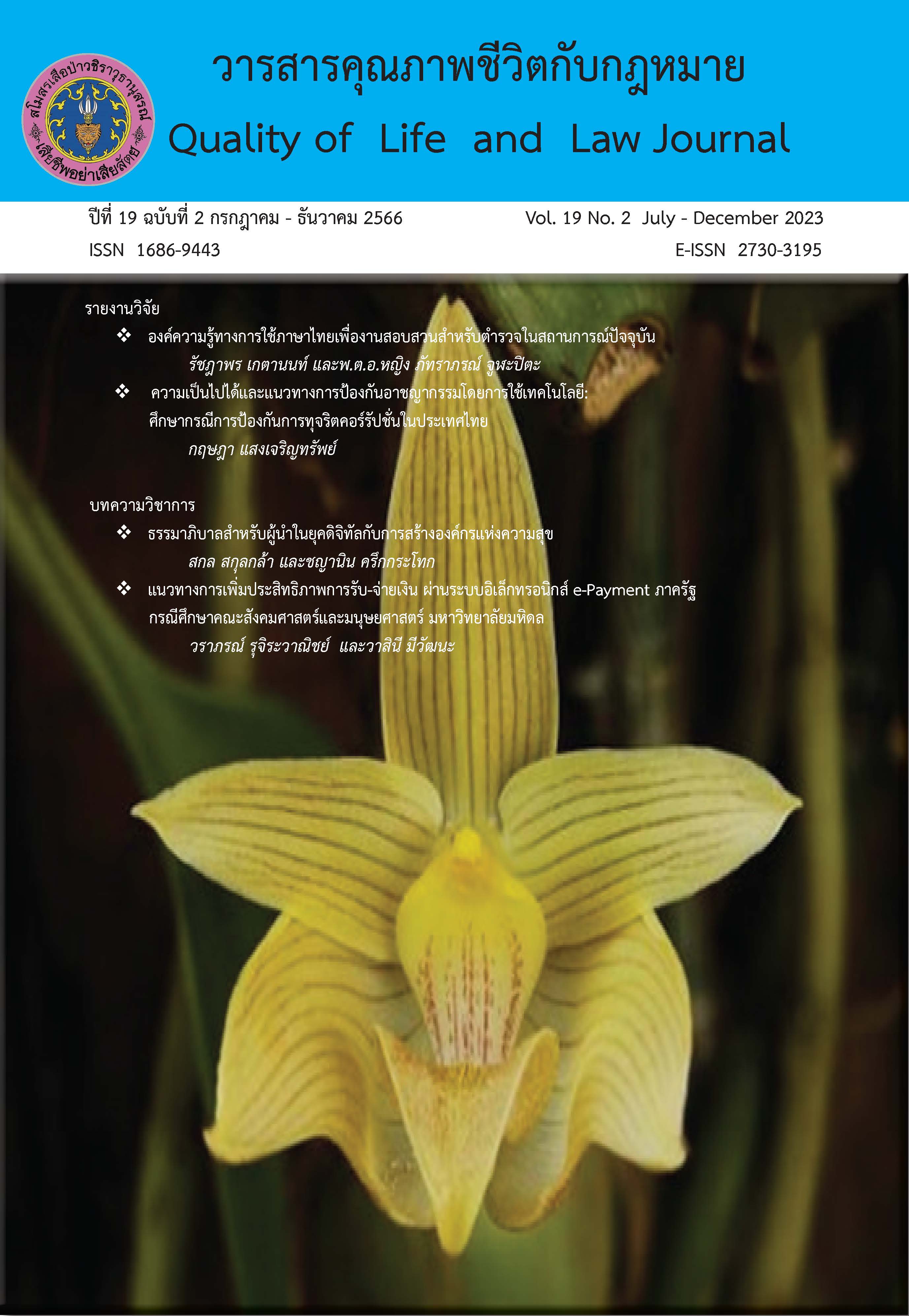Guidelines for Improving Efficiency in Receiving and Paying Through the Government’s Electronic System (E-Payment): A Case Study of the Faculty of Social Sciences and Humanities/ Mahidol University
Main Article Content
Abstract
This academic article aims to provide a guideline for improving efficiency in receiving and paying through the government’s electronic e-payment system: a case study of the Faculty of Social Sciences and Humanities/ Mahidol University. The analysis is based on document information and reports from the MU-ERP system for the fiscal year 2021 to 2023 for an overview. The author applies the ECRS concept/ using the questioning principle/ which involves Elimination/ Combination/ Rearrangement/ and Simplification. This analysis aims to improve the efficiency of the electronic e-payment system in receiving and paying through the government’s electronic E-payment systems in the government sector of the faculty. To ensure the successful operations of the faculty in alignment with its goals and mission/ financial and fiscal processes should prioritize the transition towards a fully cashless society. This can be achieved by leveraging technology to facilitate the task of department officials/ making processes more convenient/ efficient/ secure/ ultimately reducing reliance on traditional banking transactions and enhancing overall work efficiency by the committee’s role. In alignment with the country’s strategic plan/ the government sector is actively promoting projects designed to enhance electronic payment infrastructure. These initiatives aim to transition the nation towards a cashless society/ establishing electronic channels for receiving.
The recommendations suggest the development of a payment system that can be transferred through banking services without the need to create master vendor or creditor information in the MU-ERP system. In the case that there are items paid to faculty members/ this will be able to reduce costs in terms of cheque costs shorten the time required to deposit cheques at bank offices and significantly shorten the overall transaction processing time.
Article Details

This work is licensed under a Creative Commons Attribution-NonCommercial-NoDerivatives 4.0 International License.
- บทความหรือข้อคิดเห็นใดๆ ในวารสารคุณภาพชีวิตกับกฎหมายเป็
- กองบรรณาธิการไม่สงวนสิทธิ์
References
E-Payment คืออะไร?. (2019/April 8). วิกิพีเดีย สารานุกรมเสรี. สืบค้นเมื่อวันที่ 16 กรกฎาคม 2566/ เข้าถึงได้จาก https://www. getinvoice.net/e-payment-2/
กลุ่มตรวจสอบภายใน กรมธุรกิจพลังงาน กระทรวงพลังงาน. (2561). คู่มือการตรวจสอบการรับ-จ่ายเงิน ผ่านระบบอิเล็กทรอนิกส์ (e-payment). สืบค้นเมื่อวันที่ 16 กรกฎาคม 2566/ เข้าถึงได้จาก https://www.doeb.go.th/ias/data/e-payment_manual290861.pdf
ข่าวมหาวิทยาลัยมหิดล. (2561). มหาวิทยาลัยมหิดล ก้าวสู่การเป็น Digital Convergence University. งานสื่อสารองค์กร กองบริหารงานทั่วไป สำนักงานอธิการบดีมหาวิทยาลัยมหิดล. สืบค้นเมื่อวันที่ 5 สิงหาคม 2566/ เข้าถึงได้จาก https://mahidol.ac.th/th/2018/digital-convergence-university/
ขวัญเรือน จันทร์เชื้อแถว. (2566). ซักซ้อมความเข้าใจการใช้งานรหัสเจ้าหนี้และวิธีการจ่ายเงินของระบบบัญชีเจ้าหนี้ (AP). เอกสารบรรยาย จัดโดยกองคลัง งานบัญชีและพัฒนาระบบ มหาวิทยาลัยมหิดล.
ปรียาพร วัฒนปัญญาขจร. (2560). ประสิทธิภาพการจ่ายเงินของส่วนราชการผ่านระบบอิเล็กทรอนิกส์ ของกองคลัง มหาวิทยาลัยเทคโนโลยีราชมงคลธัญบุรี. การค้นคว้าอิสระ บริหารธุรกิจมหาบัณฑิต วิชาเอกการบัญชี คณะบริหารธุรกิจ มหาวิทยาลัยเทคโนโลยีราชมงคลธัญบุรี. สืบค้นเมื่อวันที่ 5 กันยายน 2566/ เข้าถึงได้จาก http://www.repository.rmutt.ac.th/dspace/bitstream /123456789/3769/1/RMUTT_158624.pdf
วิทยา อินทร์สอน. (มปป.). เทคนิคการเพิ่มผลผลิต โดยการลดการสูญเสีย. ข่าวสารเพื่อการปรับตัวก้าวทันเทคโนโลยีอุตสาหกรรม INDUSTRIAL TECHNOLOGY REVIEW, no.288. สืบค้นเมื่อวันที่ 5 กันยายน 2566. เข้าถึงได้จาก http://thailandindustry.com/onlinemag/view2.php?id= 1421§ion=4&issues=81
รายงานข้อมูลรับ-จ่ายในระบบ MU-ERP ปีงบประมาณ 2564 – 2566. คณะสังคมศาสตร์และมนุษยศาสตร์ มหาวิทยาลัยมหิดล.
ธนาคารแห่งประเทศไทย. (2565). ทิศทางการพัฒนาระบบการชำระเงินภายใต้ภูมิทัศน์ใหม่ภาคการเงินไทย. สืบค้นเมื่อวันที่ 5 สิงหาคม 2566/ เข้าถึงได้จาก https://www.bot.or.th/content /dam/bot/financial-innovation/digital-finance/Payment-DirectionalPaper-TH.pdf


